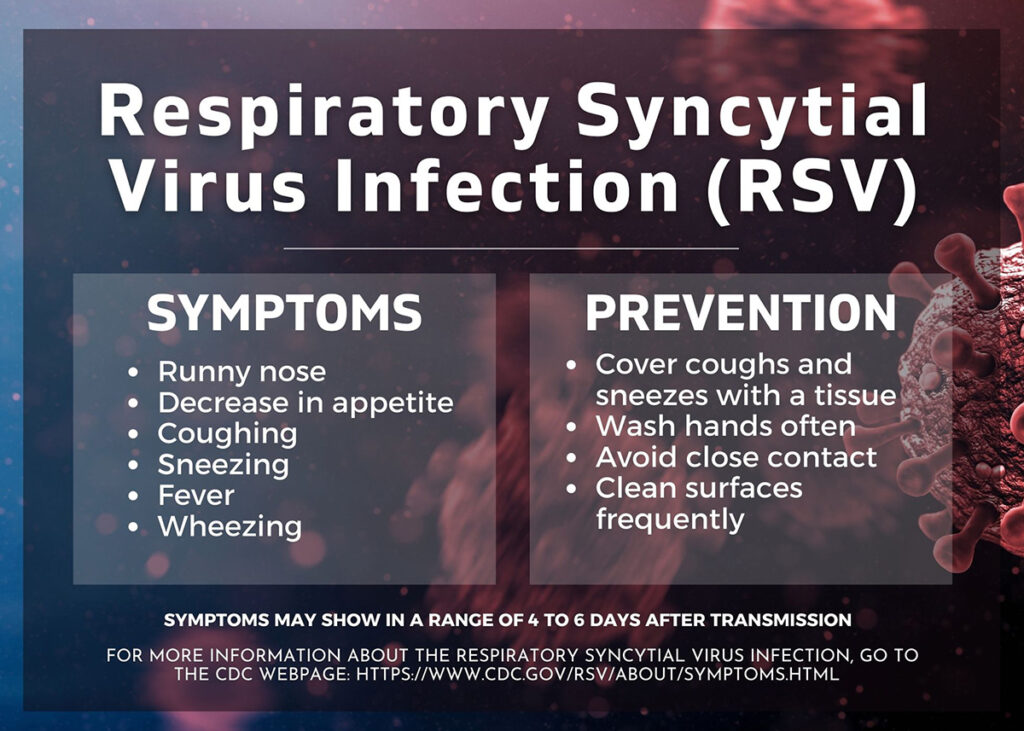
The Centers for Disease Control and Prevention have detected a high number of cases of respiratory syncytial virus (RSV) early in its season compared to previous years, including in the states of Minnesota and Colorado, where the infection rate is 55% and 49%, respectively.
RSV is a common respiratory virus that usually causes mild, coldlike symptoms, especially in infants and older adults, according to the CDC website.
Eddie Olivarez, chief administrative officer for Hidalgo County Health and Human Services, said case numbers have been increasing in the last few months because of the lack of precaution.
“So the last two and a half years of [COVID-19], a lot of the children had not been going to school, had not been going to daycare, [and] had been at home,” Olivarez said. “Many of them had been wearing masks. … So the natural exposure to RSV had been limited. So all of a sudden, this year, students get back to daycares, back to school and they had not built natural immunities to it and we’re seeing this uptick in RSV cases here in Hidalgo County and throughout the state.”
The Rider asked Esmeralda Guajardo, Cameron County health administrator, for an interview, but Guajardo told the newspaper in a Nov. 17 email that RSV “is not a reportable condition and so we do not have information on the number of cases in Cameron County.”
“Your best resource would be either a pediatrician or a hospital,” she wrote.
As of Nov. 17, Texas was not participating in RSV surveillance, according to the CDC website.
Olivarez said hospitals and doctors’ offices give an overall indication of flu and RSV cases through sentinel sites.
“It’s not an exact number but it gives us a good indicator of where we stand, and right now, we’re seeing some high numbers, in fact, even for the flu,” he said.
One of the main things Olivarez recommends to prevent the spread of RSV and the flu is to be current with vaccination.
“I know that after COVID, a lot of people are COVID fatigued and they’re tired of hearing of vaccinations and all that, but the reality is flu vaccines work,” he said. “Medication works.”
Olivarez encourages individuals and parents of children who are showing respiratory distress, coughing, fever and respiratory congestion to go to a doctor or physician to determine if it is RSV.
“Also, right now, this time of year, we have a lot of allergies,” he said. “We have a lot of sinus infections going on. So when you combine COVID, flu, RSV and sinus infections, it’s like the perfect storm for some of these young children. So we encourage parents, ‘Take your kids to the doctor and get [them] assessed, especially if they have a fever.’ Fever is the biggest telling part of it.”
Dr. Jaime Fergie, director of infectious diseases at Driscoll Children’s Hospital in Corpus Christi, said infants can develop lower respiratory disease from RSV.
“When it gets into the lungs, it begins to cause respiratory distress,” he said. “There is difficulty breathing. There is wheezing. Then, the infants have difficulty feeding. So many of [them] end up coming to the emergency room and being hospitalized and about 20% of them or more require admission to an intensive care unit. So it’s a very important virus, it’s very common and unfortunately can cause severe diseases.”
Because of the larger number of cases in RSV across the state, Fergie said Driscoll Children’s Hospital is asking pediatricians and family doctors to extend their hours to make it easier for parents to take their children to their offices.
He said the hospital wants the emergency room available for children who are having difficulty breathing.
“So we are expanding the resources,” Fergie said. “Our hospital [is] opening the spaces for more fast-track evaluation in the emergency room and trying to open as many beds as possible for the children with a respiratory infection, because the problem is not only RSV. The problem is that influenza is also here and is causing an extremely large number of cases. So we’re dealing with two very significant viruses at the same time at a very high level of activity.”
Driscoll Children’s Hospital sees about 100 to 200 positive tests of RSV in a week, he said.
Fergie expects the number of cases of RSV and influenza to rise.
“Well, you know, obviously, there is a limit to the number of people who can be infected,” he said. “Once everybody has been infected, then you have to see a decrease. So it is possible that in the next two or three months, we’ll see a decrease in number of cases. But right now, I expect more and more cases.”
Fergie said individuals need to take advantage of the vaccines available.
“We don’t have one routine vaccine for RSV,” he said. “But we do have a vaccine for influenza and we have a vaccine for COVID. And both … are available for anybody … 6 months of age or older. And also, for COVID-19, we have, now, the new booster vaccines that are to be given to anybody who is 5 years of age or older, two months after the prior dose. So let’s take advantage of what we have and use the vaccines to prevent illness in our communities.”





